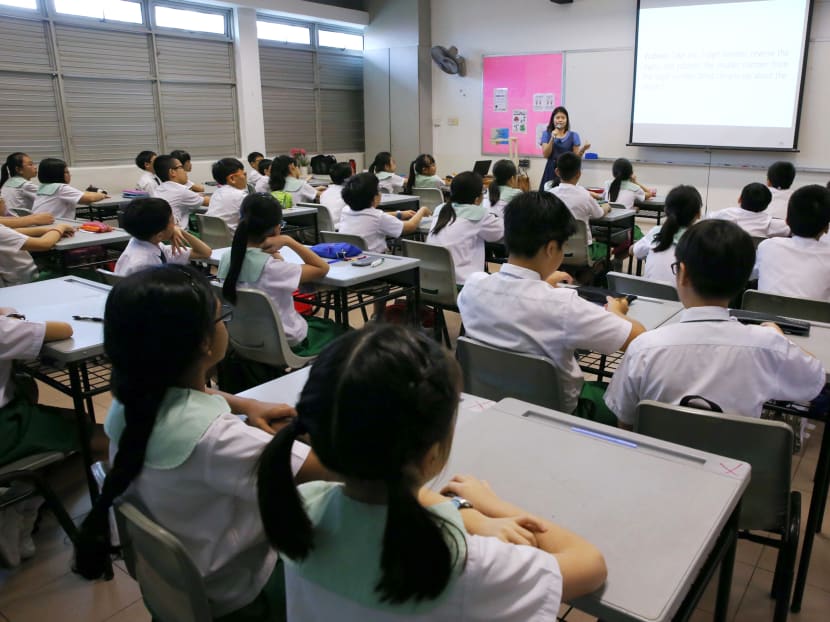MOE 'cautious' on issue of smaller class sizes: Ong Ye Kung
SINGAPORE — Making clear the stance of the Education Ministry (MOE) on the matter of class sizes, Education Minister Ong Ye Kung said that with good teachers, smaller classes help students. However, the way it is put in practice "makes all the difference", which is why the ministry is careful about it.
SINGAPORE — Making clear the stance of the Education Ministry (MOE) on the matter of class sizes, Education Minister Ong Ye Kung said that with good teachers, smaller classes help students. However, the way it is put in practice "makes all the difference", which is why the ministry is careful about it.
In Parliament on Wednesday (July 11), Mr Ong said that the MOE's approach is to grant the school the teaching resources, and "give them the flexibility to configure class sizes for different groups of students, for different subjects".
"Let me put MOE's position on this straight: With good teachers, smaller class sizes help the students. Our teachers can attest to that through first-hand experience," he said. "Why then is MOE cautious on the issue of class size? Because how it is implemented makes all the difference."
He then brought up various international studies, which concluded that there was no major impact on students' performances when they were in smaller class sizes.
One of these was a 2009 study done in Hong Kong. In a pilot involving 700 classes which were varied in sizes along the way, researchers found "no significant differences on performances compared to the territory-wide average".
Instead, they discovered that an experimental school or class performed better because they have experienced principals, who played an active role in the curriculum and developing teachers as well as encouraging parental involvement.
Another study in Israel, the finding was that there was no significant relationship between class size and achievement.
A 2011 study in the United States turned out similar findings, and a key reason was that with smaller classes, many new, inexperienced teachers were hired and they have yet to be effective in classrooms.
The report also stated that class-size reduction policies can also be "expensive and represented wasted opportunities to make smarter educational investments". Tens of billions of dollars were spent across states, especially in California and Florida, Mr Ong noted.
In recent months, there have been calls for the MOE to assess the merits of instituting smaller class sizes to help improve students' learning.
During the debate on the motion in Parliament, Nominated Member of Parliament Kuik Shiao-Yin linked the need to support teachers with smaller class sizes, saying that the reason why teachers are so strapped for time is because of "the number of learners we expect them to give individual attention to".
GOOD TEACHERS WHO FACE CONSTRAINTS
In Singapore, there are 29 students per class in primary schools and 33 to 34 for secondary schools on average.
Comparatively, for countries under the Organisation for Economic Cooperation and Development (OECD), the overall average class size in primary and secondary education stands at 21 and 24 respectively.
Ms Kuik said: "I know MOE has argued that teacher quality matters more than class size, but the sheer volume of work to be done with such large numbers of students will constrain even the most talented teacher."
She also said that the issue of class size is related to the intentions of the education system: Is it to help learners be independent in their thinking, which requires reduced class sizes, or to help learners "swallow large amounts of information"?
If it is the second, then "we can understand why huge class sizes are still tolerable because it is like raising battery hens", she added. "You can cram a lot of them in one room because you are feeding them all the same thing anyway."
While she understands that reducing class sizes is a huge investment and there are costs to conducting trials, Ms Kuik urged the MOE to still consider Non-Constituency Member of Parliament Leon Perera's proposal that the ministry conduct a small trial to assess its merits.
Mr Perera made the suggestion in Parliament last November. Mr Ng Chee Meng, who was then Education Minister (Schools), argued that class sizes are not indicative of the learning support and attention students receive. He also said then that schools do group students in smaller classes based on their learning needs.
Mr Ong gave more examples on Wednesday of such smaller class groupings.
DIFFERENT CLASSES, DIFFERENT SIZES
To support weaker students, the typical class size is 20 for specialised schools such as Crest Secondary School, Spectra Secondary School, NorthLight School and Assumption Pathway School.
In lower levels of primary schools, learning support programmes are conducted in groups of eight to 10, while many Normal (Technical) classes are taught in sizes of 20 or have two teachers in a class of 40.
Over at the junior colleges, there are also one-on-one consultations between students and teachers.
Mr Ong said: "There is sometimes still the perception that students study in one class and it is of a certain size. The reality is that students now regularly move around and join different groups and there is no single class size."
During a visit to Finland earlier this year, Mr Ong gathered feedback from teachers there on the issue. They told him that different political parties in Finland believed in different class sizes, and whichever party is elected would put into law their preferred class sizes.
However, the teachers in Finland would "rather not have the rigidity", saying that the focus should be on giving schools the teaching resources and the flexibility to configure class sizes for different groups of students, for different subjects.
"This is what Singapore has been doing," Mr Ong said.







